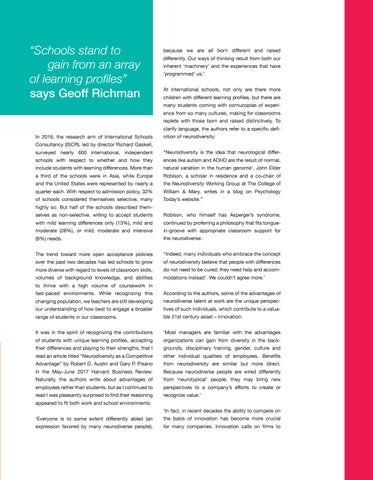“Schools stand to gain from an array of learning profiles” says Geoff Richman
because we are all born different and raised differently. Our ways of thinking result from both our inherent ‘machinery’ and the experiences that have ‘programmed’ us.’ At international schools, not only are there more children with different learning profiles, but there are many students coming with cornucopias of experience from so many cultures, making for classrooms replete with those born and raised distinctively. To clarify language, the authors refer to a specific defi-
In 2016, the research arm of International Schools Consultancy (ISCR), led by director Richard Gaskell, surveyed nearly 600 international, independent schools with respect to whether and how they include students with learning differences. More than a third of the schools were in Asia, while Europe and the United States were represented by nearly a quarter each. With respect to admission policy, 32% of schools considered themselves selective, many highly so. But half of the schools described themselves as non-selective, willing to accept students with mild learning differences only (13%), mild and moderate (28%), or mild, moderate and intensive
nition of neurodiversity: ‘‘Neurodiversity is the idea that neurological differences like autism and ADHD are the result of normal, natural variation in the human genome’, John Elder Robison, a scholar in residence and a co-chair of the Neurodiversity Working Group at The College of William & Mary, writes in a blog on Psychology Today’s website.’’ Robison, who himself has Asperger’s syndrome, continued by proferring a philosophy that fits tonguein-groove with appropriate classroom support for
(9%) needs.
the neurodiverse:
The trend toward more open acceptance policies
‘‘Indeed, many individuals who embrace the concept
over the past two decades has led schools to grow more diverse with regard to levels of classroom skills, volumes of background knowledge, and abilities to thrive with a high volume of coursework in fast-paced environments. While recognizing this changing population, we teachers are still developing our understanding of how best to engage a broader
of neurodiversity believe that people with differences do not need to be cured; they need help and accommodations instead’. We couldn’t agree more.’ According to the authors, some of the advantages of neurodiverse talent at work are the unique perspectives of such individuals, which contribute to a valua-
range of students in our classrooms.
ble 21st century asset – innovation:
It was in the spirit of recognizing the contributions
‘Most managers are familiar with the advantages
of students with unique learning profiles, accepting their differences and playing to their strengths, that I read an article titled “Neurodiversity as a Competitive Advantage” by Robert D. Austin and Gary P. Pisano in the May-June 2017 Harvard Business Review. Naturally, the authors write about advantages of employees rather than students, but as I continued to read I was pleasantly surprised to find their reasoning appeared to fit both work and school environments: ‘Everyone is to some extent differently abled (an expression favored by many neurodiverse people),
organizations can gain from diversity in the backgrounds, disciplinary training, gender, culture and other individual qualities of employees. Benefits from neurodiversity are similar but more direct. Because neurodiverse people are wired differently from ‘neurotypical’ people, they may bring new perspectives to a company’s efforts to create or recognize value.’ ‘In fact, in recent decades the ability to compete on the basis of innovation has become more crucial for many companies. Innovation calls on firms to 7
